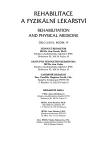-
Medical journals
- Career
Coordination Dynamic Therapy Applied in the Syndrome of Painful Shoulder
Authors: S. Klobucká; E. Žiaková
Authors‘ workplace: Rehabilitačné centrum Harmony, Bratislava primárka MUDr. S. Klobucká, Ph. D.
Published in: Rehabil. fyz. Lék., 19, 2012, No. 3, pp. 112-116.
Category: Original Papers
Overview
Shoulder joints disease is relatively frequently occurring phenomenon in rehabilitation practice.
Coordination dynamic therapy (CDT) applied by Giger MD® device integrates a comprehensive effort to a maximum rate of recovery thorax-scapula-humeral girdle muscular coordination. Giger MD® is a medical device enabling cinematically related movements of upper and lower extremities in cyclical patterns.
In this paper we documented positive effect of CDT in 51 year old patient with a history of painful shoulder.Key words:
shoulder pain, impingement syndrome, coordination dynamic therapy
Sources
1. BARBEAU, H.: Locomotor training in neurorehabilitation: emerging rehabilitation concepts. Neurorehabilitation and Neural Repair, 17, 2003, č. 1, s. 3-11.
2. BJELLE, A.: Epidemiology of shoulder problems. Baillieres Best Pract. Res. Clin. Rheumatol., 3, 1989, č. 3, s. 437-451.
3. BORGGRAEFE, I. et al.: Improved gait parameters after robotic - assisted locomotor treadmill therapy in a 6 year old child with cerebral palsy. Mov. Disord., 23, 2008, č. 2, s. 280-283.
4. BORGGRAEFE, I. et al.: Robotic - assisted treadmill therapy improves walking and standing performance in children and adolescents with cerebral palsy. European Journal of Pediatric Neurology, 14, 2010, č. 6, s. 496-502
5. CAZALETS, J. R. et al.: Localization and organization of the central pattern generator for hindlimb locomotion in newborn rat. The Journal of Neuroscience, 15, 1995, č. 7, s. 4943-4951.
6. DIETZ, V. et al.: Locomotor activity in spinal man: significance of afferent input from joint and load receptors. Brain, 125, 2002, č. 12, s. 2626-2634.
7. DUYSENS, J. et al.: Neural control of locomotion. Part 1. The central pattern generator from cats to humans. Gait and Posture, 7, 1998, s. 131-141.
8. HESSE, S.: Locomotor therapy in neurorehabilitation. Neurorehabilitation, 16, 2001, č. 3, s. 133-139.
9. HESSE, S. el al.: Upper and lowe extremity robotic devices for rehabilitation and for studying motor control. Current Opinion in Neurology, 16, 2003, č. 6, s. 705-710.
10. JAGNEŠÁKOVÁ, M.: Kinezioterapia skolióz. Diplomová práca, Lekárska fakulta UK, Bratislava, Fakulta fyzioterapie, 2011.
11. KRÁLÍČEK, P.: Úvod do speciální neurofyziologie. 3. vyd., Praha, Galén, 2011, 235 s., ISBN 978-80-7262-618-2.
12. KŘÍŽ, J. et al.: Trénink lokomoce v závěsu u pacientů po poranění míchy. Česká a slovenská neurologie a neurochirurgie, 73/106, 2010, č. 2, s. 124-130.
13. MAC KAY-LYONS, M.: Central pattern generation of locomotion : a review of evidence. Physical Therapy, 82, 2002,č. 1, s. 69-83.
14. MARDER, E., BUCHER, D.: Central pattern generators and the control of rhytmic movements. Current Biology, 11, 2001, č. 23, s. 986-996.
15. MICHENER, L. A., McCLURE, P. W., KARDUNA, A. R.: Anatomical and biomechanical mechanisms of subacromial impingement syndrome. Clinical Biomechanics, 2003, č. 18, s. 369-379.
16. SCHALOW, G., PÄÄSUKE, M., ERELINE, J., GAPEYEVA, H.: Improvement in Parkinson’s disease patients achieved by coordination dynamics therapy. Electromyogr. Clin. Neurophysiol., 44, 2004, č. 2, s. 67-73.
17. SCHALOW, G.: Phase and frequency coordination between neuron firing as an integrative mechanism of human CNS self-organization. Electromyogr. Clin. Neurophysiol., 45, 2005, č. 6, s. 369-383.
18. SCHALOW, G., PÄÄSUKE, M., JAIGMA, P.: Integrative reorganization mechanism for reducing tremor in Parkinson’s disease patients. Electromyogr. Clin. Neurophysiol., 45, 2005, č. 7-8, s. 407-415.
19. SCHALOW, G., JAIGMA, P.: Cerebral palsy improvement achieved by coordination dynamics therapy. Electromyogr. Clin. Neurophysiol., 45, 2005, s. 433-445.
20. SCHALOW, G.: Functional development of the CNS in pupils between 7 and 19 years. Electromyogr. Clin. Neurophysiol., 46, 2006, č. 3, s. 159-169.
21. SCHALOW, G.: Hypoxic brain injury improvement induced by coordination dynamics therapy in comparison to CNS development. Electromyogr. Clin. Neurophysiol., 46, 2006, č. 3, s. 171-183.
22. SCHALOW, G., JAIGMA, P.: Improvement in severe traumatic brain injury induced by coordination dynamics therapy in comparison to physiologic CNS development. Electromyogr. Clin. Neurophysiol., 46, 2006, č. 4, s. 195-209.
23. SCHALOW, G.: Surface EMG and coordination dynamics measurements-assisted cerebellar diagnosis in a patient with cerebellar injury. Electromyogr. Clin. Neurophysiol., 46, 2006, č. 6, s. 371-384.
24. SCHALOW, G.: Symmetry diagnosis and treatment in coordination dynamics therapy. Electromyogr. Clin. Neurophysiol., 46, č. 7-8, 2006, s. 421-431.
25. SCHALOW, G.: Cerebellar injury improvement achieved by coordination dynamics therapy. Electromyogr. Clin. Neurophysiol., 46, č. 7-8, 2006, s. 433-439.
26. SCHALOW, G., VAHER, I., JAIGMA, P.: Overreaching in coordination dynamics therapy in an athlete with a spinal cord injury. Electromyogr. Clin. Neurophysiol., 48, 2008, č. 2, s. 83-95.
27. TRNAVSKÝ, K., SEDLÁČKOVÁ, M. et al.: Syndrom bolestivého ramene. 1. vyd., Praha, Galén, 2002, ISBN 80-7262-170-X.
28. VARCHOLOVÁ, M.: Využitie combofitu v rehabilitácii skolióz. Diplomová práca, SZU, Bratislava, Fakulta ošetrovateľstva a zdravotníckych odborných štúdií, 2010.
http://www.gigermd.com/
Labels
Physiotherapist, university degree Rehabilitation Sports medicine
Article was published inRehabilitation & Physical Medicine

2012 Issue 3-
All articles in this issue
- Changes in the Leg Locomotion at the Adult and Old Age in Comparison of Standing Position and Walking
- Coordination Dynamic Therapy Applied in the Syndrome of Painful Shoulder
- Sulfane as a New Gaseous Hormone – Importance for the RFM Branch
- Shiatsu in the Physiotherapy Context
- The Process of Health State Evaluation for the Social Security Purposes
- Physiotherapy of Patients with Multiple Sclerosis - Questionnaire Survey
- Comparing the Effects of Various Forms of Regeneration after Load by Myotonometry
- Rehabilitation & Physical Medicine
- Journal archive
- Current issue
- Online only
- About the journal
Most read in this issue- Sulfane as a New Gaseous Hormone – Importance for the RFM Branch
- Coordination Dynamic Therapy Applied in the Syndrome of Painful Shoulder
- Changes in the Leg Locomotion at the Adult and Old Age in Comparison of Standing Position and Walking
- Shiatsu in the Physiotherapy Context
Login#ADS_BOTTOM_SCRIPTS#Forgotten passwordEnter the email address that you registered with. We will send you instructions on how to set a new password.
- Career

